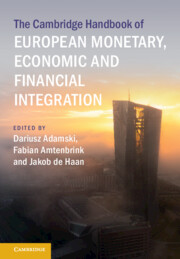Book contents
- The Cambridge Handbook of European Monetary, Economic and Financial Integration
- The Cambridge Handbook of European Monetary, Economic and Financial Integration
- Copyright page
- Contents
- Contributors
- Introduction
- Part I The Economic and Monetary Union
- Part II The Monetary Dimension
- 9 The Overburdened Monetary Policy Mandate of the ECB
- 10 Government Bond Buying by the European Central Bank
- 11 ECB Monetary Policies
- 12 From Market to Green Economics
- 13 The Politics of Monetary Union and the Democratic Legitimacy of the ECB as a Strategic Actor
- 14 How Can Courts Contribute to Accountability in EU Monetary Policy?
- Part III The Economic and Fiscal Dimensions
- Part IV Financial Integration
- Index
- References
11 - ECB Monetary Policies
The Increasing Importance of Communication
from Part II - The Monetary Dimension
Published online by Cambridge University Press: 28 September 2023
- The Cambridge Handbook of European Monetary, Economic and Financial Integration
- The Cambridge Handbook of European Monetary, Economic and Financial Integration
- Copyright page
- Contents
- Contributors
- Introduction
- Part I The Economic and Monetary Union
- Part II The Monetary Dimension
- 9 The Overburdened Monetary Policy Mandate of the ECB
- 10 Government Bond Buying by the European Central Bank
- 11 ECB Monetary Policies
- 12 From Market to Green Economics
- 13 The Politics of Monetary Union and the Democratic Legitimacy of the ECB as a Strategic Actor
- 14 How Can Courts Contribute to Accountability in EU Monetary Policy?
- Part III The Economic and Fiscal Dimensions
- Part IV Financial Integration
- Index
- References
Summary
Over the recent two decades, monetary policy has increasingly become the art of managing expectations. As a consequence, central bank communication has become an important instrument in central banks’ toolkits. Central bank communication was initially primarily focused on financial markets. Recently, however, central banks started paying increasing attention to communication with the general public. The European Central Bank (ECB) is no exception. Although communicating with the general public is important, it is not clear whether non-experts are within reach of the ECB. Even if they receive the communications, it cannot be taken for granted that they process them, and do so appropriately, as non-experts might lack the relevant background or because the communication by the central banks is too complex. However, even if central bank communication with the general public may have limited impact on inflation expectations, central bank accountability simply requires that central banks talk (and listen) to the general public. Clear and easy to understand communication to the general public is essential for the ECB’s legitimacy. The ECB should therefore primarily focus on explaining its price stability mandate in communicating to the general public, and do so in a relatable manner.
- Type
- Chapter
- Information
- Publisher: Cambridge University PressPrint publication year: 2023



